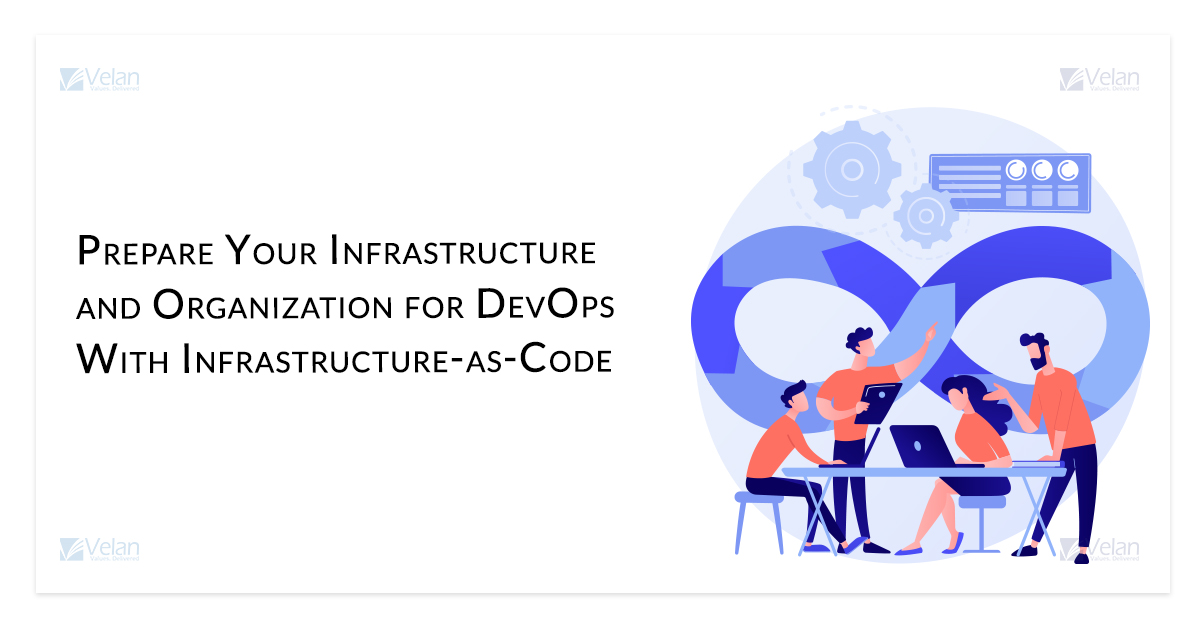Prepare Your Infrastructure and Organization for DevOps With Infrastructure-as-Code 21 Dec 2020

Reminiscing the old server days will remind you how servers used to occupy large floor space.
And business owners had to be very careful about the locality they would lease, power supply, full-time resources, and ensure availability of servers 24*7 to operate a business without any hiccup. And the system administrators would have to be alert all the time because a small issue in the server could put a lot of business things at stake. So, the system administrators had to ensure the good health of servers for critical business applications to function seamlessly.
As the advancement started coming in, backend management started evolving gradually.
The evolution has made server management effortless that it no longer requires 24*7 administration and long hours to configure it. All thanks to the Cloud and DevOps!
Cloud technology completely redesigned the way infrastructure is handled. DevOps services transformed software development and deployment.
Cloud and DevOps are revolutionary concepts, and it has brought a lot of benefits for the software development businesses.
DevOps has made the software development life cycle faster, efficient, and secure. Automation is the crux of the DevOps ideology – removing manual processes and launching smarter and efficient tools to facilitate recurrent delivery pipeline.
Out of the many ideologies of DevOps, Infrastructure as Code (IAC) is remarkable. With IAC, you can build, deploy, and manage the entire organization’s infrastructure effortlessly.
Infrastructure is an essential aspect of software development, and it is considered as the cornerstone for the whole process.
What is Infrastructure as Code?
Microsoft defines IAC as, “Infrastructure as Code is the management of infrastructure (networks, virtual machines, load balancers, and connection topology) in a descriptive model, using the same versioning as DevOps team uses for source code”.
Put simply, IAC is the concept of handling the infrastructure using code. It represents the latest practices of managing the infrastructure (storage, data servers, and networking requirements). It leverages machine-readable files to establish the required IT infrastructure to test and run your code. With IAC, you can treat infrastructure just like another code.
What is the need for Infrastructure as Code (IAC)?
With Infrastructure as Code, system administrators can automate the process of establishing and configuring a virtual machine using code. It allows the work to be done at a rapid pace and gives the provision to replicate the entire process flow. Meaning, if you build a virtual environment to build an application using a code, you can use the same code, and replicate the process of developing that virtual machine for deployment.
IAC is equivalent to creating scripts in IT process automation. The difference between the two is that in the latter, scripts can be used to automate only static steps, and there is no flexibility for complicated processes and actions. It is not the same with IAC, system administrators will get complete freedom and flexibility towards the code using the scripts. IAC gives you information about the kind of infrastructure that is built. And this eliminates the need for manual configuration, and IAC code will do it for you.
How Infrastructure as Code (IaC) enables DevOps best practices?
As you already know, DevOps is the union of development and operations teams whose objective is to mitigate cycle time and make sure of continuous delivery to the customers. In addition to this, DevOps (enhanced deployment) provides more windows to enhance the application and gain an understanding and learn from the mistakes.
Infrastructure as Code employs code and automation implementation to begin and teardown of particular environments. The practice is unlike the usual conventional methods that are associated with humans handling virtual machines manually. The whole automation process reduces the cycle time making it seamless and easier to create and deliver stable, tested platforms to host applications.
Another famous DevOps is Version Control. With this, distributed and large teams can successfully work together using a definitive and established system. IaC makes the development environment clear and transparent similar to how code makes version control effective and better. It relaxes the need to document everything for the developers and the end-users to understand. This way, IaC contributes to producing better and easier results with error-replication and error-tracking enabling quicker turnaround.
Furthermore, IaC records all environment build-up commands in a storehouse authorizing redeployment or faster roll back to the previous instance. It means that you do not need to exhaust your time on fixing a server. Instead, you need to either look into the version history to reinstate a previous deployment or reuse it with a working copy.
There are four best practices of IaC, and they are:
- Handling infrastructure via source control to provide comprehensive audit tracks for change and improvements.
- Assessing the infrastructure for any errors and issues using integration testing, unit testing, and functional testing.
- Facilitating collaboration around infrastructure configuration and provisioning.
- Avoiding written documentation as the code itself will record the state of the machine.
What are the benefits of Infrastructure as Code (IAC)?
The remarkable advantages of using Infrastructure as Code are:
- Enhanced system performance: IaC runs 24*7 without the need for a system admin to take care of it. It promises risk prevention by offering timely assurance on problematic domains. It ensures the safety and compliance of IT infrastructure together with the quick response to issues and/or requirements.
- Speed: Software delivery decides the fate of the business’s success, especially in today’s automation world. Infrastructure as Code empowers software delivery at high momentum by accomplishing all IT related requirements.
- Change management: Before the code goes live and the software is released into the production environment, the code is modified and tested for error umpteen times. IaC makes sure of efficient and secure change management in different platforms, systems, and devices.
- Scalable infrastructure: IaC enables organizations to scale efficiently and quickly. Hardware Virtualization makes it seamless to add auxiliary resources, replacing them, and scaling whenever required.
- Improved customer satisfaction: In addition to saving your time and cost, IaC helps you to provide an enhanced customer satisfaction experience due to its ability to deliver quicker services at an affordable price.
What are the best tools of Infrastructure as Code (IaC)?
There are quite a few best tools for IaC. You must select the tools that will help your business and make the process easier for you.
- AWS CloudFormation
- Google Cloud Deployment Manager
- Azure Resource Manager(ARM Templates)
- Terraform — open-source IaC tool
- Puppet
- Chef — popular IaC tool
- Pulumi
- Ansible — popular configuration management tool
- SaltStack
A few tools listed above belong to the baron cloud service providers while a few of them are owned by the DevOps tools providers.
Final Thoughts
If you are contemplating adopting DevOps Infrastructure as Code, then let us tell you that it is a good decision. Embracing Infrastructure as Code will help you deal with fewer challenges and enable a quicker setup. Another reason is that you will not need huge space and time to set up and maintain the server like it initially required.





